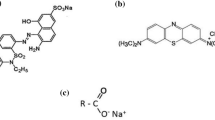Abstract
Hard water can decrease the detergency efficiency of surfactants due to a significant concentration of divalent cations as Ca2+ or Mg2+. The formulation of a cleaning detergent must be modified and it is usual to add more surfactants or a huge quantity of sequestrating agents. This supplementary addition can have deleterious effects on the environment and increases the price of the formulation. A surfactant, presenting both detergency capacities in the presence of Ca2+ and Ca2+ chelating properties, would be of great interest. In this paper, we report on Ca2+ extraction with sugar-based chelating surfactants using an experimental device, namely a flotation column, as both chelating properties and foaming properties in the presence of Ca2+ are important in the flotation process as well as in detergency. Among all the sugar-based surfactants tested, a few of them were able to extract calcium and thus demonstrated the expected characteristics.

Similar content being viewed by others
References
Rosen MJ (1989) Surfactants and interfacial phenomena, 2nd edn. J. Wiley, New York, pp 363–392
Rodriguez CH, Lowery LH, Scamehorn JF, Harwell JH (2001) Kinetics of precipitation of surfactants. I. Anionic surfactants with calcium and with cationic surfactants. J Surfactants Deterg 4:1–14
Goon P, Bhirud RG, Kumar VV (1999) Detergency and foam studies on linear alkylbenzene sulfonate and secondary alkyl sulfonate. J Surfactants Deterg 2:489–493
Bandyopadhyay S, Das SK, Sarkar A (2009) A method of building of hard water and a builder system for a detergent composition. PCT Int Appl WO 2009077327, 25 pp
Rosen MJ (1989) Surfactants and interfacial phenomena, 2nd edn. J. Wiley, New York, pp 108–170
Stellner KL, Scamehorn JF (1989) Hardness tolerance of anionic surfactant solutions. 1. Anionic surfactants with added monovalent electrolyte. Langmuir 5:70–77
Stellner KL, Scamehorn JF (1989) Hardness tolerance of anionic surfactant solutions. 2. Effect of added nonionic surfactant. Langmuir 5:77–84
Soontravanich S, Scamehorn JF (2010) Use of a nonionic surfactant to inhibit precipitation of anionic surfactant by calcium. J Surfactants Deterg 13:13–18
Homendra N, Devi CI (2006) Micellar behaviour of mixed surfactant system of linear alkyl benzene sulfonate and Triton X-100 in pure and hard water. J Surf Sci Technol 22:119–131
Wattebled L, Laschewsky A (2007) New anionic gemini surfactant based on EDTA accessible by convenient synthesis. Colloid Polym Sci 285:1387–1393
Hill K, von Rybinski W, Stoll G (eds) (1997) Alkyl polyglycosides. Technology, properties and applications. VCH, Weinheim
Carnero Ruiz C (ed) (2009) Sugar-based surfactants. Fundamentals and applications. Surfactant science series 143. CRC Press, Boca Raton
Angyal SJ (1989) Complexes of metal cations with carbohydrates in solution. Adv Carbohydr Chem Biochem 47:1–43
Ferlin N, Grassi D, Ojeda C, Castro MJL, Grand E, Fernández-Cirelli A, Kovensky J (2008) Synthesis of sugar-based chelating surfactants for metal removal from wastewater. Carbohydr Res 343:839–847
Ferlin N, Grassi D, Ojeda C, Castro MJL, Grand E, Fernández-Cirelli A, Kovensky J (2010) Synthesis of new chelating surfactants from octyl d-glucopyranosiduronic acid and amino acids for metal flotation. Carbohydr Res 345:598–606
Castro MJL, Ritacco H, Kovensky J, Fernández-Cirelli A (2001) A simplified method for the determination of critical micelle concentration. J Chem Educ 78:347–348
Brown GM, Dubreuil P, Ichhaporia FM, Desnoyers JE (1970) Synthesis and properties of some α-d-alkyl glucosides and mannosides: apparent molal volumes and solubilization of nitrobenzene in water at 25 °C. Can J Chem 48:2525–2531
Castro MJL, Kovensky J, Cirelli F (2002) A new family of nonionic gemini surfactants. Determination and analysis of interfacial properties. Langmuir 18:2477–2482
Rosen MJ (1989) Surfactants and interfacial phenomena, 2nd edn. J. Wiley, New York, pp 276–303
Böcket T, Thiem J (1989) Synthese und Eigenschaften von Kohlenhydrattensiden. Tenside Surfactants Deterg 26:318–324
Acknowledgments
The authors are indebted to DGA (fellowship to N. F.), Universidad de Buenos Aires, Centre National de la Recherche Scientifique (CNRS) and Ministère délégué à l’Enseignement Supérieur et à la Recherche for financial support. This work was also supported by a Binational Cooperation France-Argentina, CNRS and Consejo Nacional de Investigaciones Científicas y Técnicas (CONICET).
Author information
Authors and Affiliations
Corresponding authors
About this article
Cite this article
Ferlin, N., Grassi, D., Ojeda, C. et al. Calcium Chelating Sugar-Based Surfactants for Hard-Water Detergency. J Surfact Deterg 15, 259–264 (2012). https://doi.org/10.1007/s11743-011-1310-3
Received:
Accepted:
Published:
Issue Date:
DOI: https://doi.org/10.1007/s11743-011-1310-3




